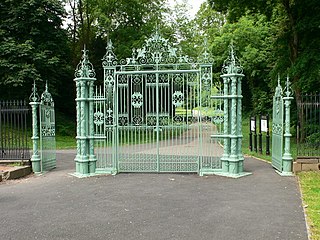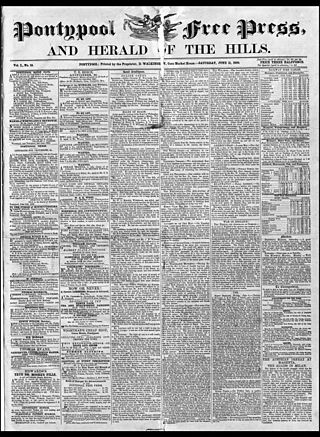
Abersychan is a town and community north of Pontypool in Torfaen, Wales, and lies within the boundaries of the historic county of Monmouthshire and the preserved county of Gwent.

Cwmbran is a town in the county borough of Torfaen in South Wales.

Pontypool is a town and the administrative centre of the county borough of Torfaen, within the historic boundaries of Monmouthshire in South Wales. As of 2021, it has a population of 29,062.
Outokumpu Oyj is a group of international companies headquartered in Helsinki, Finland, employing 10,600 employees in more than 30 countries. Outokumpu is the largest producer of stainless steel in Europe and the second largest producer in the Americas. Outokumpu also has a long history as a mining company, and still mines chromium ore in Keminmaa for use as ferrochrome in stainless steel. The largest shareholder of Outokumpu is the Government of Finland, with 26.6% ownership, including the shares controlled by Solidium, The Social Insurance Institution of Finland, Finnish State Pension Fund and Municipality Pension Agency.

Blaenavon is a town and community in Torfaen county borough, Wales, high on a hillside on the source of the Afon Lwyd. It is within the boundaries of the historic county of Monmouthshire and the preserved county of Gwent. The population is 6,055.
Varteg is a village in the county borough of Torfaen in Wales.

The Pontypool and Blaenavon Railway is a 3.5-mile (5.6 km) volunteer-run heritage railway in South Wales, running trains between a halt platform opposite the Whistle Inn public house southwards to the town of Blaenavon via a two-platform station at the site of former colliery furnace of the Big Pit National Coal Museum.

New Inn - - is a village and community directly south east of Pontypool, within the County Borough of Torfaen in Wales, within the historic boundaries of Monmouthshire. It had a population of 5,986 at the 2011 Census.

Pontypool and New Inn railway station is situated to the south east of Pontypool town centre between the town and the suburb of New Inn, Wales. The station was formerly called Pontypool Road until renamed just Pontypool in 1972 and then to the present name in 1994.
Griffithstown is a large suburb of Pontypool in the borough of Torfaen, Wales, within the historic boundaries of Monmouthshire. It is an ecclesiastical parish, formed in May 1898, from Llanfrechfa Upper and Panteg, and includes Sebastopol, but, under the provisions of the Local Government Act 1894, became a separate civil parish.

Pontypool Park is a 150-acre (0.61 km2) park in Pontypool, Torfaen, Wales. The park was formerly the grounds of Pontypool House and was laid out in the closing years of the 17th century for John Hanbury, an ironmaster, who is closely associated with Japanware. The grounds were purchased by the local authority in 1920, while the estate house was leased, and later sold, to the Sisters of the Holy Ghost to become St. Alban's RC High School. The former stables now house the Torfaen Museum. The grounds contain a number of structures including a double ice house, the Folly Tower and the Shell Grotto. The park is entered through the Pontymoile Gates. The gates, the grotto and the stables are all Grade II* listed structures, while the former hall and the ice house are listed Grade II. The park itself is designated at Grade II* on the Cadw/ICOMOS Register of Parks and Gardens of Special Historic Interest in Wales.
Samuel Fox and Company was a company operating a major steel complex built in the Upper Don Valley at Stocksbridge, near Sheffield, South Yorkshire, England.

Panteg is a large village and community in the county borough of Torfaen, Wales. It is adjacent to Griffithstown, between the towns of Cwmbran and Pontypool. The village is best known for Panteg Steel Works, which closed in 2004.

Blaenavon Ironworks is a former industrial site which is now a museum in Blaenavon, Wales. The ironworks was of crucial importance in the development of the ability to use cheap, low quality, high sulphur iron ores worldwide. It was the site of the experiments by Sidney Gilchrist Thomas and his cousin Percy Gilchrist that led to "the basic steel process" or "Gilchrist–Thomas process".

Sebastopol railway station was a railway station which served the village of Sebastopol near Pontypool in Torfaen, South Wales, UK.
Panteg and Griffithstown railway station was a railway station which served Griffithstown near Pontypool in Torfaen, South Wales, UK.

The Pontypool Free Press is an English language weekly regional newspaper that was originally published in Pontypool, as the Pontypool Free Press and Herald of the Hills, in 1859 and is circulated in Pontypool and the surrounding area of Torfaen, in south-east Wales.
Panteg AFC is a Welsh football club located in Griffithstown, Pontypool, Torfaen, South Wales. The club was founded in 1935 and currently runs two senior teams and one youth team at its home ground, Panteg House Sportsgrounds. The club plays in the Gwent County League Division One, tier 5 of the Welsh football pyramid.

Dneprospetsstal, known as DSS, is a Ukrainian manufacturer of special stainless steel. The company is based in Zaporizhia in southeastern Ukraine, and was founded as a state-run enterprise in 1932. Its full name is JPrSC Electrometallurgical Works Dneprospetsstal named after A. N. Kuzmin. It is a publicly traded company.














